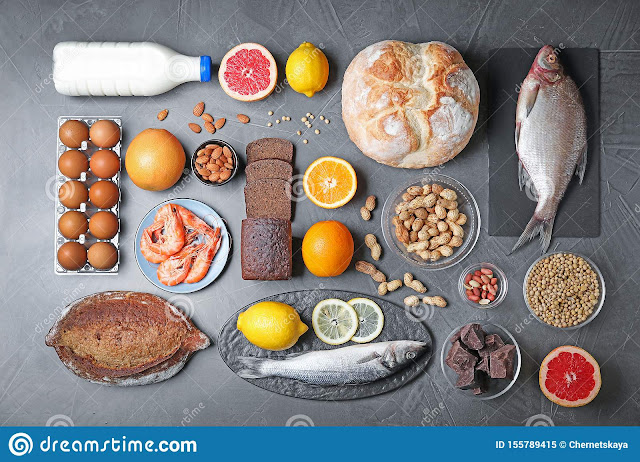Neonatal nutrition, food allergy, food contaminants and urolithiasis in brief.
- Get link
- X
- Other Apps
1.
Discuss and summarize neonatal nutrition.
A neonate is a newborn infant child under 28 days of age- who is
in rapid development and at a very high risk of dying. The requirement for the growth and
development of organs creates great challenges to the nutrition management of
newborns. The chief source of nutrition
for neonates is breastfeeding. The daily requirements of neonatal are broadly
categorized into macronutrients and micronutrients. Under macronutrients carbohydrates, proteins,
and fats fall whereas micronutrients comprise vitamins, water, and
minerals. As a prime source of nutrients
for neonates, breast milk comprised of:
|
Water |
86.5% |
|
Milk
sugar lactose |
4.8% |
|
fat |
4.5% |
|
Protein |
3.5 |
|
Vitamins
and minerals |
0.5% |
The protein requirement for a neonate to meet the structural and
functional roles of cells and tissue is 18gm/kg/day, below which a state of
malnutrition called kwashiorkor occurs.
For body energy, carbohydrate is required 60gm/day, while lipids/fats are usually absorbed in the form of TGA contributing 40-50% of bodily calories
should be in the range of 31-50gm/day. The
necessary vitamins, which regulate the body of metabolism and gene expression, consist
of A, C, D, E, K, and B6, B12 in decreasing order of their requirement ranging
from 400mg/day to 0.4 mg/day.
The WHO
recommends breastfeeding to be the exclusive source of neonatal nutrition
against cow milk and formula milk at least for 6-months provided that no
complications occurred during the breastfeeding. Breastfeeding brings about excellent
mutual health benefits for both baby and maternal health, prevention of ovarian and breast cancer, mother-baby bond boost, and so on.
References:
Neville, M.C., Anderson, S.M., McManaman,
J.L. et al. Lactation and Neonatal Nutrition: Defining and
Refining the Critical Questions. J Mammary Gland Biol Neoplasia 17, 167–188
(2012). https://doi.org/10.1007/s10911-012-9261-5
2. Write
a note on food allergies.
Food
allergy
Food allergy is an immune system reaction that occurs after
eating a certain food. For people with
food allergies, even a small amount can trigger signs and symptoms such as
digestive problems, itching, irritation, swollen airways, etc. The symptoms can
vary from mild to severe; in an extreme case food allergy leads to
anaphylaxis. There is not yet a curable
medicine for food allergy. Food allergy can be divided into three types on the
basis of source, they are:
a. Plant-based food allergy
A large number of plant-based allergen components have been
identified to date. Plants, including
peanut, wheat, nuts, fruits, and soybean are frequent sources of fatty acids. More
than 60% of plant-derived food allergens belong to the four protein families/
super-families of prolamin, cupin, pathogenesis-related protein 10 (PR- 10),
and profilin. Allergy to nuts is widely increasing in the whole world. Some people
are also highly allergic to pollen and pollen-based products.
b. Animal-based food
allergy
Cow's milk and hen's eggs are the most common animal sources of food allergy for infants whereas in adults it's seafood and fish.
c.
Mold allergy
Molds produce mycotoxins (aflatoxins) which have neurotoxic,
carcinogenic properties. Such toxins are
produced by fungus that grows on vegetation and various staple stored food items
especially nuts, cereals, sesame seeds, sunflower seeds, etc.
There are two major classes of food allergic reactions: IgE
mediated and non- IgE mediated. IgE-mediated allergic reactions are present
soon after ingestion and are comparatively easy to investigate, are more
severe than non-IgE-mediated reactions leading to death through anaphylaxis.
The only way of preventing food allergy is a complete stop
of consuming food and food products that contain ingredients that caused
allergies.
References:
Bruijnzeel-Koomen C, Ortolani C, Aas K et
al. Adverse reac-tions to food : position
paper. Allergy 1995;50 :623–35
3.
Discuss the food contaminants and their hazards
to human health.
Food contamination is
defined as food that is spoiled or tainted either they contain
micro-organisms like bacteria, virus, or fungus or due to the presence of toxic
substances that makes food unfit for consumption. These contaminants have
several routes of entry from farm to fork and lead to serious illnesses in human health. The WHO has also recognized food contamination is the next big
challenge to human health and healthy living. There are four types of food
contaminants, namely physical, chemical, biological and allergenic.
Chemical contaminants:
Chemicals
that are frequently used for cleaning and disinfectant can also contaminate the
food. Contamination may
occur from preparing food on a surface that still has chemical residue on it or
if someone sprays cleaning chemicals close to uncovered food. There are also chemicals that occur naturally
in foods, like toxins in some fish, and in some cases, minimal chemical
contamination might not actually lead to illness. Chemical food contaminants that
can enter the food supply chain include pesticides, heavy metals, and other
alien chemical agents.
Physical
contaminants:
Physical
contamination of food refers to food that has been contaminated by a foreign
object at some stage of the production process. Types of physical contaminants that
can be found in food include jewelry, hair, plastic, bones, stones, pest
bodies, and cloth. Physical contamination includes hair, fingernails, bandages,
broken glasses, pest drooping, plastic dirt, etc.
Biological
contamination:
Biological
contamination occurs when food becomes contaminated by living organisms or the
substances they produce. This includes biological matter produced by humans,
rodents, insects and microorganisms. Biological contamination is the leading
cause of food-borne illness and food poisoning, and a common cause of food
spoilage and food waste. Six types of microorganisms can cause food-borne illness that includes bacteria, viruses, parasites, protozoa, fungi, and prions. Bacillus cereus, Campylobacter jejuni, Clostridium
botulinum, C. perfrigens, Pathogenic Escherichia
coli, Listeria monocytogenes, Salmonella spp., Shigella spp.,
Pathogenic Staphylococcus aureus, Vibrio cholera, V.
parahaemolyticus, V. vulnificus, and Yersinia
enterocolitica are common bacterial hazards (a type of biological
contaminant). Bacillus cereus, Campylobacter jejuni, Clostridium
botulinum, C. perfrigens, Pathogenic Escherichia
coli, Listeria monocytogenes, Salmonella spp., Shigella spp.,
Pathogenic Staphylococcus aureus, Vibrio cholera, V.
parahaemolyticus, V. vulnificus, and Yersinia
enterocolitica are common bacterial hazards (a type of biological contaminant).
Allergenic
contamination:
Allergenic contamination occurs when food that causes an
allergic reaction comes into contact with another food. For example, if the
same knife used to cut normal bread is then used to cut gluten-free bread, or
if pasta is stored in a tub that used to contain peanuts. These are the foods that account for the majority of food
allergies in people. The list includes things like gluten, peanuts, eggs,
mustard, soy, and fish. For someone with a food allergy, consuming even a tiny
amount of that food is enough to cause a fatal reaction. As a result, it’s
essential that you prevent allergenic contamination of food on your premises.
References:
Katepogu Kamala, Venkobarao
Pavan Kumar, Chapter 1 - Food Products and Food Contamination, Microbial
Contamination and Food Degradation 2018, Pages 1-19
Hussain
MA. Food Contamination: Major Challenges of the Future. Foods.
2016;5(2):21. Published 2016 Mar 23. doi:10.3390/foods5020021
4.
Discuss urolithiasis.
Kidney stones (also called renal calculi, Nephrolithiasis, or urolithiasis ) are hard precipitation made of minerals and salts due to
disruption in the balance between solubility and precipitation of salts and
minerals. The incidence of urolithiasis reaches its peak in the population aged
over 30 years. Males are more likely to suffer from urinary calculi. Because of different dietary
habits or genetic backgrounds, differences in prevalence among races or
nationalities also exist.
Chemical constituents of Stones:
Nowadays, in the most of the
countries of Asia calcium oxalate(75-90%)
is the most common component of UUT(upper urinary tract) stones followed
by uric acid( 5-20%), calcium phosphate (6-13%), struvite (2-15%) ,apatite(1%)
and cystine(0.5-1%). In typical countries like China, India and Indonesia, the
proportion of calcium Oxalate and uric acid stones has increased since the 1960s.
Risk factors:
Risk factors associated with the
formation of urinary calculi can be divided into two main groups, intrinsic and extrinsic factors. The former includes age, gender, ethnic and familial
backgrounds; while the latter group consists of climate and environment,
lifestyle and dietary habits, occupation, and education level. The most
important factors, in determining the prevalence, incidence, recurrence rates, and
constituent of calculi, are climate and dietary habits. Apart from urinary tract
infection or renal tubular acidosis; patients with urolithiasis are frequently
documented to be with metabolic diseases, like diabetes mellitus, hypertension, or adiposity, which may be another risk factor for urinary tract stones
Symptoms:
Unless the stone moved around
within the kidney or passes into the ureters(the tube connecting the bladder and
the kidneys) there will be no observation of symptoms. If it becomes lodged in
the ureters, it may block the flow of urine and cause the kidneys to swell and
the uterus to spasm, which can be very painful. At this point following signs and symptoms will be seen:
1. Severe, sharp pain in the back,
below the ribs in the lumbar region.
2. Pain that radiates to the lower
abdomen region and groin
3. Pain or burning sensation
during urinating.
4. Pink red or brown urine.
5. Cloudy or foul-smelling pink-red urine
6. A persistent need to urinate,
frequent urinating, and urinating in a small amount
7. Nausea and fever.
Treatment:
For small kidney stones, doctor
recommend
1. To drink plenty of fluids and
reduce sodium intake.
2. Alpha-blockers (medicine to
help pass stone)
3. Anti-inflammatory drug to cope with pain.
For large stones, surgery is required. The main
types of surgery are:
1. Shock wave lithotripsy
2. Uterescopy
3. Percutaneous nephrolithotomy
(PCNL)
There's an old saying of
"prevention is better than cure". So in order to prevent urolithiasis following points should be considered:
1. Lose weight
2. Quit smoking and alcohol
consumption.
3. Involve in physical exercise
4. Consume food that has low
cholesterol, and sodium.
5. Maintaining blood pressure.
References:
Alan S.L. Yu MB, BChir,
in Brenner and Rector's The Kidney, 2020
Kumar SBN, Kumar KG, Srinivasa V,
Bilal S. A review on urolithiasis. Int
J Universal Pharmacy Life Sci. 2012;2:269-280.
- Get link
- X
- Other Apps



Comments
Post a Comment